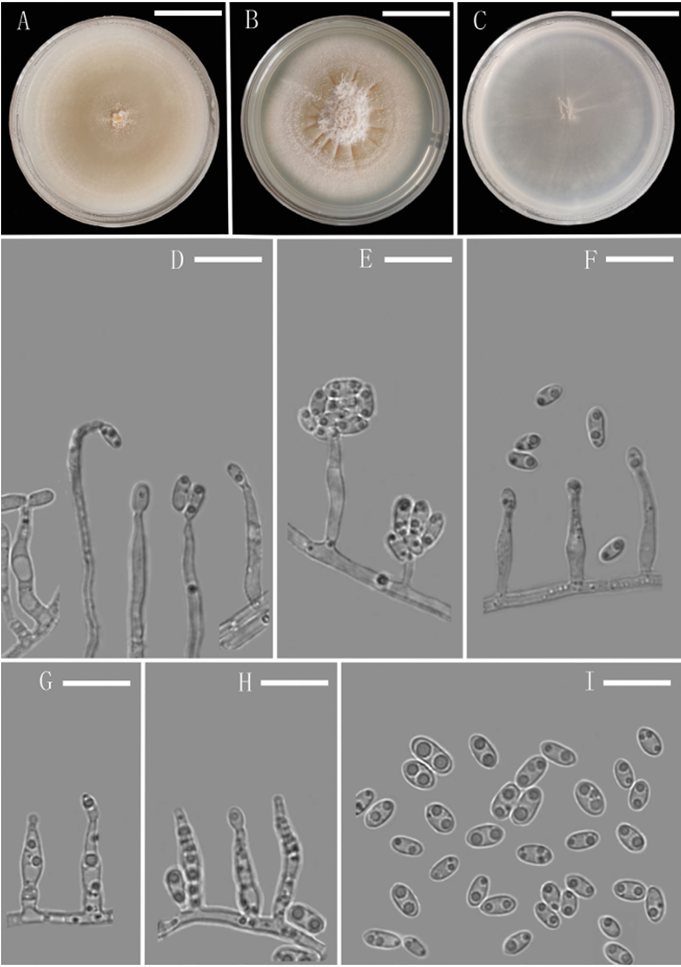 82
82
Plectosphaerella sichuanensis Z.F. Yu & X.Q. Yang, sp. nov.2021
MycoBank No: 838657
Holotype: China, Sichuan Province, Daofu, 30°98'N, 101°13'E, 2960 m alt., isolated from Potamogeton pectinatus as an endophyte, 20 Jul. 2015, Z.F. Yu, YMF 1.05081 (Holotype), ex-type CCTCC AF 2021054, another strain checked: YMF 1.05082.
Morphological description
Sexual morph: Undetermined
Asexual morph: Colony on CMA after 3 d, vegetative hyphae hyaline, septate, com monly branched, smooth, thin-walled, mostly 2.5–3.5 µm ( = 2.9 µm, n = 10) wide. Conidiophores macronematous, mononematous, erect, straight or flexuous to sinuate, hyaline, smooth, unbranched or rarely branched, aseptate. Conidiogenous cells phialides, integrated, terminal, determinate, subulate, hyaline, smooth. Conidia ac rogenous, ellipsoidal, unicellular, smooth-walled, hyaline, 1–3 guttulate, 4.2–6.8 × 2.5–3.7 µm ( = 5.2 × 3.3 µm, n = 30), forming hyaline to white mucilaginous masses. Sexual morph and chlamydospores absent.
Culture characteristics: Colonies on OA reaching 50 mm diameter, on PDA reaching 47 mm diameter and on CMA reaching 42 mm diameter in 14 d at 25 °C. On PDA, colonies pale brown to white, flat, repressed, plicated, partly immersed, a few white aerial hyphae grew in the middle of the medium, margin regular, frontier distinct, reverse pale brown to white.
Habitat:
Distribution: China
GenBank Accession: LSU MW027535; ITS MW027539; TEF-1α MW309880; TUB2 MW441780
LSU MW027536; ITS MW027534; TEF-1α MW441775; TUB2 MW441781
Notes: In the phylogenetic tree, the closest species to Plectosphaerella sichuanensis is P. populi, but P. populi can be distinguished from P. sichuanensis by its smaller aseptate conidia (Crous et al. 2015). The size and shape of conidia of P. sichuanensis is more similar to P. cucumerina, expect that P. cucumerina presents longer phialides (up to 69 µm) (Carlucci et al. 2012). In addition, P. sichuanensis resembles P. citrullae Carlucci et al., P. pauciseptata and P. oratosquillae in lacking septate conidia. However, it can be distinguished from P. citrullae by polyphialides conidiogenous cells; from P. paucisep tata and P. oratosquillae by bi-guttulate conidia (Duc et al. 2009; Carlucci et al. 2012).
Reference: [1] Yang, X. , Ma, S. , Peng, Z. , Wang, Z. , Qiao, M. , & Yu, Z. . (2021). Diversity ofplectosphaerellawithin aquatic plants from southwest china, withp. endophyticaandp. sichuanensisspp. nov. MycoKeys, 80, 57-75.
Plectosphaerella sichuanensis (YMF 1.05081, holotype) A–C colony on OA, PDA and CMA after 14 d D–H conidiophores and Phialides I conidia. Scale bars: 1.35 cm (A–C), 10 µm (D–I).

